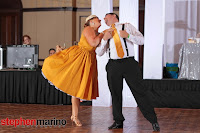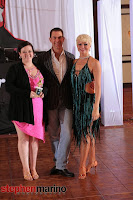Are you ready to learn something? For this week's manager's forum question, we asked the managers AND the Dance Director's at the Arthur Murray Dallas and Plano studios for their explanation of the difference between "using the floor" and "floorcraft". What we ended up with were these awesome answers!
 |
| Ian & Sarah at the 2012 Texas Showdown |
Ian: "Using the floor" simply means pushing off the floor with your feet so that you can move more easily and with more fluidity. "Floorcraft" is actually how you get around the floor. In both smooth and rhythm, but more so in smooth, you really have to be able to navigate your way around the floor so that you can fully get into the dance and truly express all of it's characteristics without running into other couples.
 |
| Adriann at the 2013 Cancun Showcase |
Adriann: When your teacher says "use the floor", he or she is referring to the way you use your feet against the floor to move yourself. Like jumping, your feet pushing against the floor, uses the floor as leverage to move your body. "Floor-Craft" is, essentially, driving. Remember, when you're dancing, you're the only car on the road, so don't run yourself or your partner in to anyone else.
 |
| Justin & Nikki competing |
Justin: To me, "using the floor" deals with how your foot interacts with the floor, where "floorcraft" deals with navigating and direction of movement around the floor.
So when we talk about using the floor, we want to be aware of what part of our foot touches the floor, how we slide or roll along the floor with our foot, and how we use friction with the floor to move against it. For instance,
pushing the edge of your foot against the floor to move in the opposite direction is an example of using the floor. This is why it's important to keep your shoes brushed, as we need texture to create friction between the foot and floor. This is also what we are referring to when we talk about dancing on top of the floor versus "using the floor." Cuban Motion, for example, should be a result of your feet and legs
interacting with the floor, not just a lot of movement near the surface.
Floorcraft, on the other hand, will relate to where you face on the floor, and how you move around it. Room alignments, like Line of Dance, help you aim your traveling figures. Understanding that certain figures serve specific purposes--like traveling, rotating, or picture steps-- will help you choose which figure to use next. It's important for men especially to develop skills to protect his partner from other less-aware couples, as well know how to brake quickly or "shoot the gap." For both men and women, it's important to know etiquette for dancing on a crowded floor compared to an open floor with more space between dancers. Size of step and arm styling can effect floorcraft because it concerns your neighbors on the dancefloor.
The less-dance-nerdy version is that using the floor is pushing on the floor with your feet to make your dancing more comfortable and balanced. Floorcraft is making sure you don't run in to people when you're dancing. Clear as mud, right?
 |
Lindsey & Ian at the
2013 Texas Showdown |
Lindsey: Using the floor vs floor craft
To me, I have a mental image when it comes to these topics. Picture this:
1) imagine one of your favorite movies where the scene depicts a king preparing for battle by seeing an areal view of the landscape and sees how his chess pieces can move in the most strategic way.
For a man on the dance floor, his teacher is his trusted advisor that intentionally created the flight plan for his most successful and skillful route around the floor. You can see this skill by observing the plan from an areal view and see how it maps out to your advantage. This is the art of using the floor.
But scenario 2 comes into play when the actual battle begins and plan turns into action. For example:
2) The man is aware of what he needs to accomplish and then he himself realizes that there will be obstacles that will try to thwart the plan. Imagine this idea:
You are actually on the battlefield in the front line. In that moment, the leader is in the moment, knows what he is supposed to do, however must adjust his strategy to what the reality is and find the best way to maneuver through the unknown. This is the art of floor craft.
Therefore, there should always be a plan to what a leader wants to accomplish, but also have a fine balance between strategy and what reality will throw at you.
 |
| Nikki & Justin at the 2012 Showdown |
Nikki: The difference between "using the floor" and "floorcraft" is a huge one when I am teaching...
I can certainly see where "using the floor" can mean using all corners and such; however, if I'm teaching, I'm referring to your feet on the actual floor. A lot of times when I see people dance I see surface movement, meaning that they are using the big muscles in their legs, but no muscles in their feet. When you are dancing, it should actually be the tiny muscles in your feet that work to move you from foot to foot, and across the floor... Not your thighs, or head weight. Imagine standing on one foot with the other in the air... (or actually try it!) then pushing from the leg you are standing on, jump onto the one you just had in the air. Using the floor is very much like that. Another analogy is to think of the old school tread mills... The one's that weren't motorized. In order to start them, you had to push hard with your feet into the belt and then make it slide backwards. That's also "using the floor." One last thought for those of you that used to be in marching band. Do you remember how to roll your feet to move across the field so that your instrument didn't bounce? That is also "using the floor." If you can look at your feet, point your toes and notice little muscles pop up from being flexed, good job! You are "using the floor!" If you can't, just keep working! It will come.
Now, as for "floorcraft..." Well, I think this the most important skill that a man can develop in dancing. This is the road map that a man will use to get around the floor. "Floorcraft" is often looked at like a chess board. How is each piece moving, and which piece is moving at a particular time. However, since I am terrible at chess, I have to think of it as driving on a highway. Back in the old days, before GPS, we all had to plan our own trips based on maps. Then, if we ran into traffic, we had to do some quick recalculating of our own and find a new route. Dancing is the same way. We can set out on doing a specific set of steps, and traveling a specific way, but if there is traffic, an accident, or a lane closure, we have to be will to adjust, and adjust quickly. This is often pretty easy if we are dancing rhythm, as we are not trying to move around the floor... But in smooth, we have to make sure that we are not the car waiting till the last minute to try and get over, or the car that ignores the caution signs and ends up as part of the problem.
Both techniques make dancing a much more enjoyable experience for all involved, so make sure you are studying both!
 |
| Sarah at the 2013 Cancun Showcase |
Sarah: What a wonderful question! All the true dance nerds will surely eat this up and get very excited about it! So here it goes;
Floor craft is like driving a car in traffic. Sometimes the traffic is heavy, sometimes it's light but you can learn how to drive you and your partner around like a Ferrari! Most times you start like a Mack truck and as you learn different patterns you can begin to grow your agility, your response time becomes faster and you handle the turns and breaks better! FUN!
"Using the Floor" is how you use the relationship between your feet and the only constant thing in dancing ( the floor) to move your body. Using the floor with your feet is the same as how a tire uses tread. It gives the car traction, groundedness, control and a smooth strong ride. So yes, they both have to do with the QUALITY of movement, but in two very different ways. Floor craft = quality of movement in a crowd or in the "big picture".
Using the Floor = quality of movement in your own body from your feet and how you feel, just to your partner.
What I really love about doing this post each week is that you can very clearly see the benefit of learning from as many of our instructors as possible. Everyone interprets, understands, and explains things just a little differently, and when you take all that information in and let it simmer for awhile, what comes out will be a amazingly well-balanced dancing!











